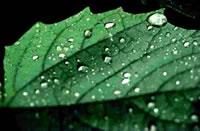 The greener the land the more likely rain.FAO / M. Marzot
The greener the land the more likely rain.FAO / M. MarzotMore rain makes for more plant growth: that much is obvious. But now a statistical study of satellite images has added weight to the reverse notion: more plants also make for more rain.
The result adds to the impetus to preserve green spaces in dry regions, in order to help prevent deserts from growing and encroaching on agricultural land.
Greenery can have a number of effects on a local climate. Plants are thought to transfer moisture from the soil into the air by evaporation from their leaves, and hold water in the soil close to the surface, where it can also evaporate. What is more, the darker surfaces of plants compared to sandy deserts also absorb more solar radiation, which, along with their rough texture, can create convection and turbulence in the atmosphere. This might create more — or less — rainfall.
All of these effects have been incorporated into climate models. But there has been disagreement about which effects were dominant and why, and how much impact it all has.
The new work concludes that vegetation effects account for around 30% of annual rainfall variation in Africa's Sahel region. The results are reported in Geophysical Research Letters1.
That should help scientists understand rainfall patterns in the area, which is threatened with increasing desertification and periods of drought. "It gives us an additional element of predictability: a bit of an edge in knowing where it might rain," says study co-author Peter Cox, director of the Climate and Land Surface Interactions Centre (CLASSIC) UK.
How green is your desert?
Sea-surface temperatures and pollution from dust and aerosols have a large effect on rainfall patterns. These factors can affect long-term climate trends, including decadal African droughts. But they have less of an influence on annual rainfall patterns in 'hotspots' such as the Sahel. Here other factors, including vegetation, play a large role in the weather, says Cox.
To unpick the effect of vegetation in this area, the researchers combined rainfall records from 1982 to 1999 with a dataset developed from NASA satellites giving a measure of the Sahel's greenness (vegetation coverage) over the same period.
A simple correlation between greenness and rainfall would only show that periods of lush vegetation were likely to occur in wet seasons - hardly a surprising conclusion. So the researchers took a more subtle approach. They first examined how well past rainfall levels predicted the rainfall yet to come for each month over an 18-year period. They then added in an extra predictive factor: the previous month's greenness. If vegetation had no effect on rainfall, the predictive skill of the model would not change. But including the greenness measure did make it easier to predict subsequent rainfall levels — by 30%.
This is a conservative estimate of the impact of vegetation, says co-author and CLASSIC programme manager Sietse Los, because their technique could not measure the effect of vegetation on the same month's rainfall.
The finding suggests that rain encourages greenery, which in turn creates more rainfall; likewise an arid surface should tend to keep the atmosphere dry.
Water cycle
ADVERTISEMENT
The result should help settle some debate about how, exactly, plants impact on the water cycle. "Climate models can give a wide range of answers on this problem," says Robert Dickinson, who studies climate at the Georgia Institute of Technology. "A data-driven analysis [like this one] has more credibility."
But, Dickinson warns, satellite data can be interpreted in many different ways, so more independent studies would be welcome.
Han Dolman, of the Free University of Amsterdam, points out that the measure of 'greenness' doesn't reveal whether any particular type of vegetation is responsible for increasing rainfall. It would be good to know, he says, whether only trees and crops have this effect, or if grasses can also contribute.
Visit our plantsmakemorerain.html">newsblog to read and post comments about this story.
